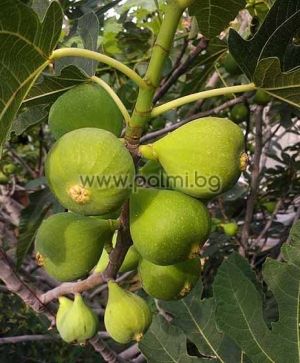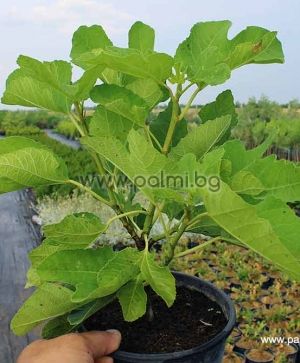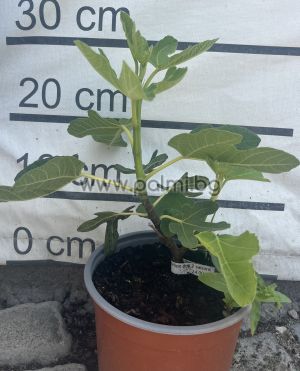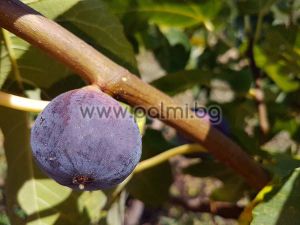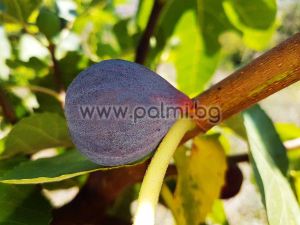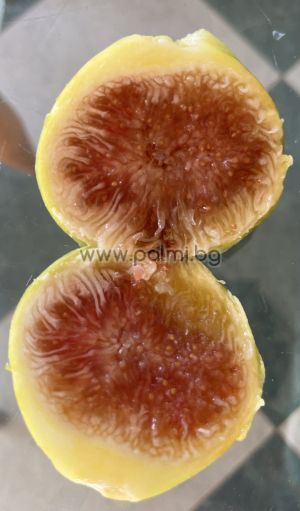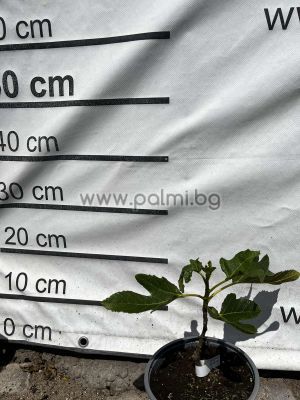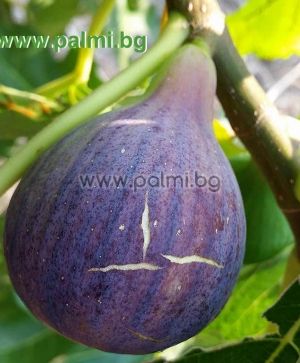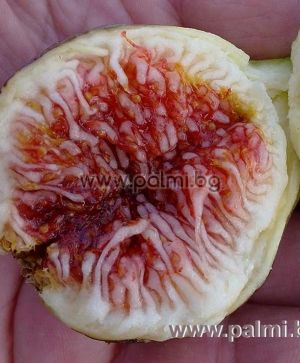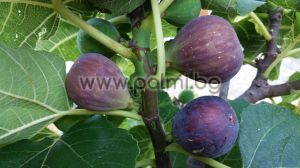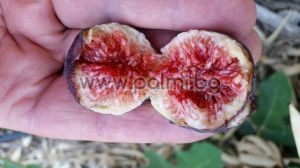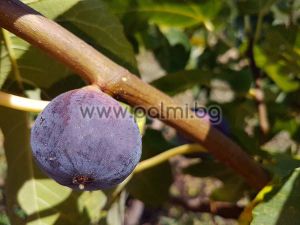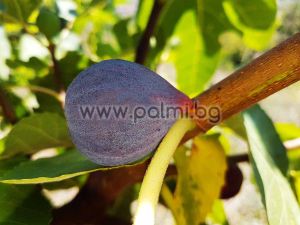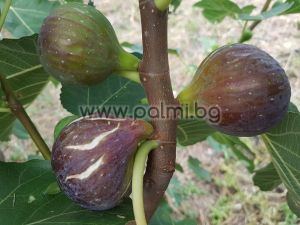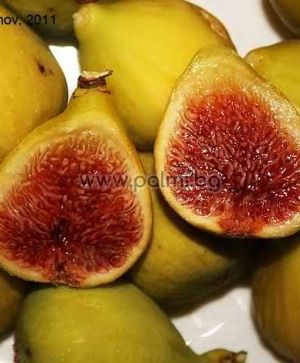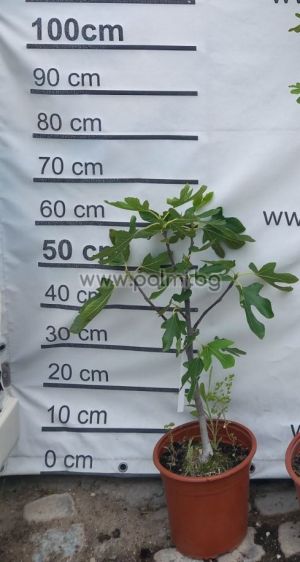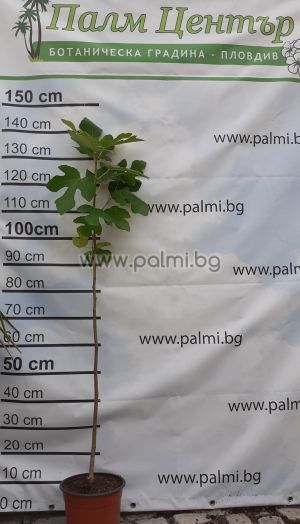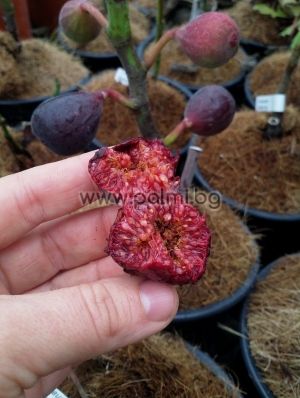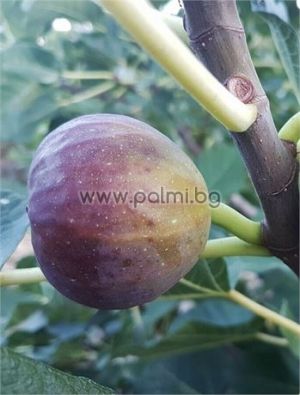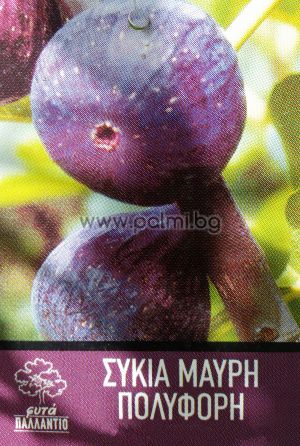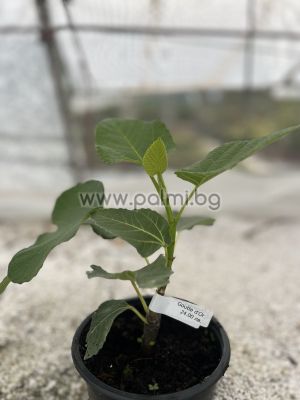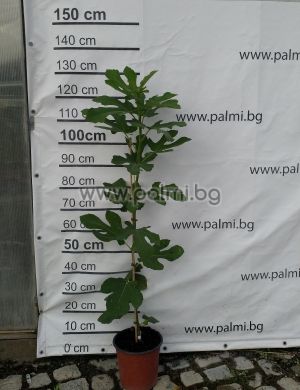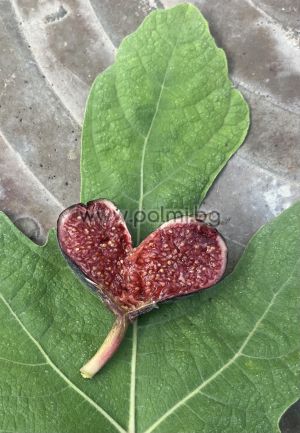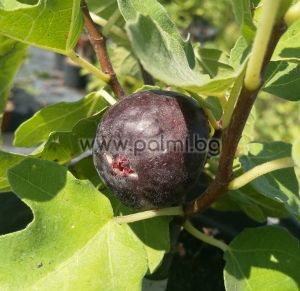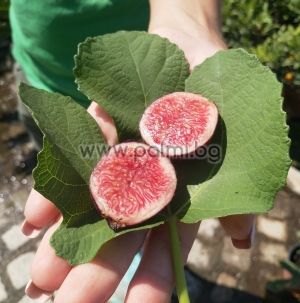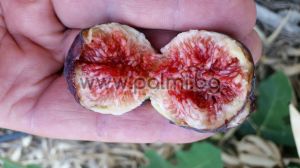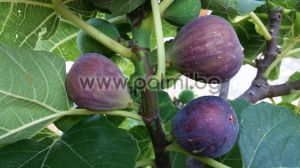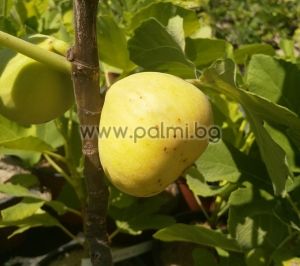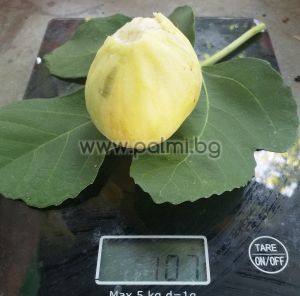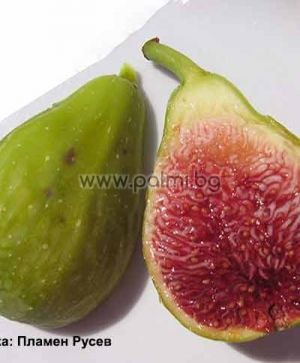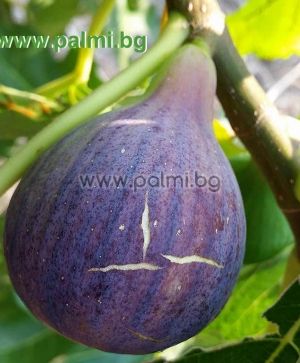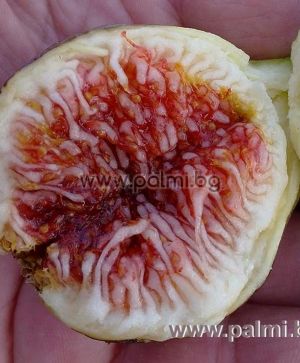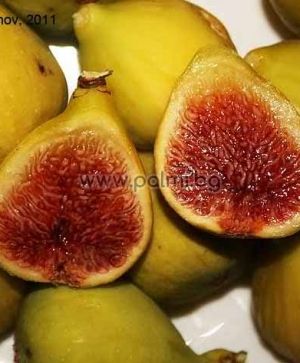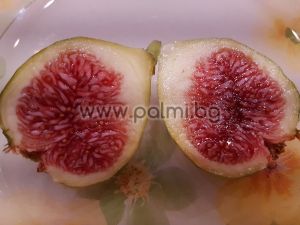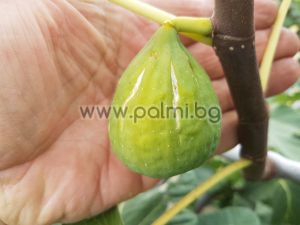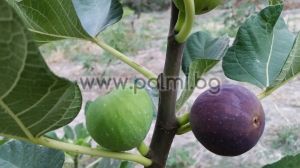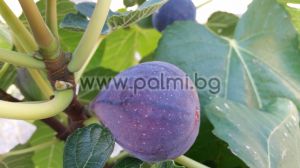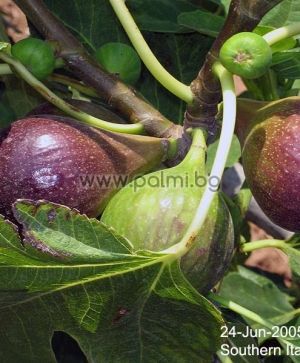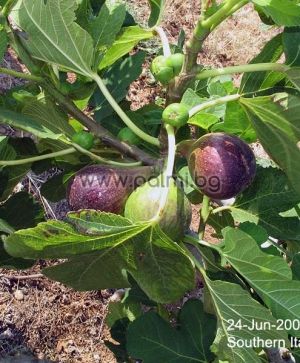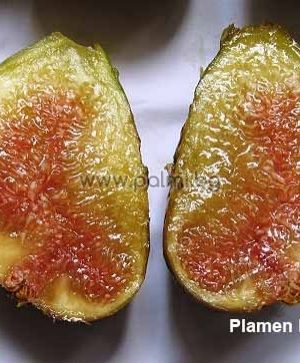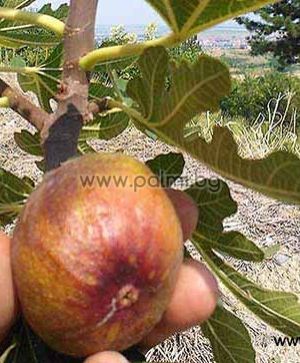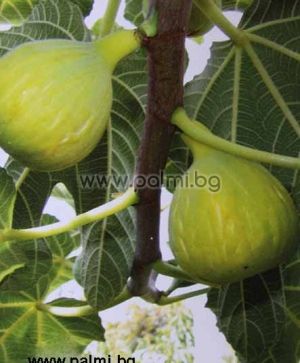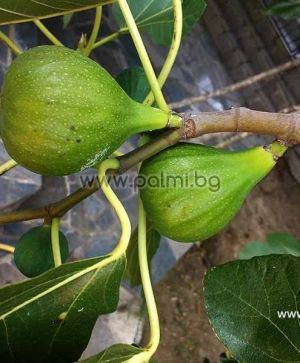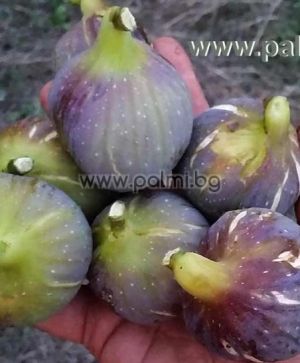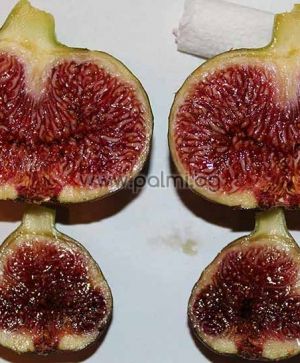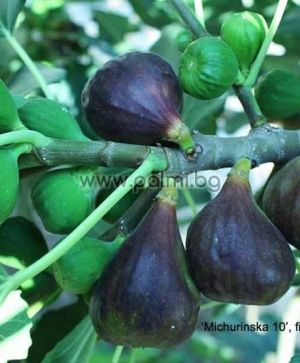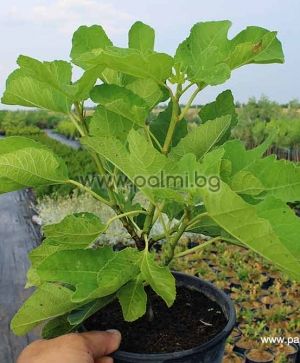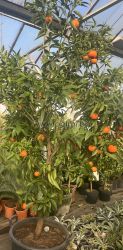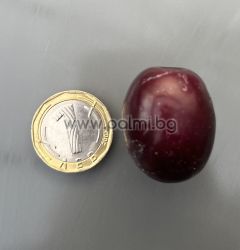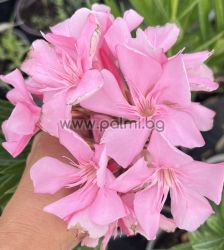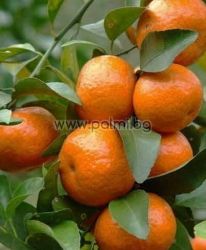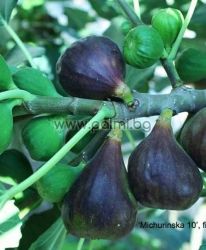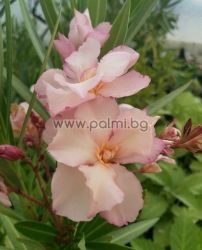Fig varieties
Fig varieties in our nursery.
Male Fig variety , Pollinator,var.3
Ficus carica Male var.3, Male Fig Pollinator from Botanical Garden - Plovdiv, Bulgaria
This Male Fig will pollinate all Fig varieties! If there is no pollination, the fruits will remain smaller and with worse quality, than the pollinated fruits. For comparison, please see the picture with cut fruits, the bigger ones are pollinated. The smaller ones are not pollinated.
The common fig is a species of the genus Ficus (Ficus) in Mulberry family (Moraceae). In the genus Ficus there are about 2,000 tropical and subtropical species - trees, shrubs and lianas distributed almost worldwide.
The fruit of all species of Ficus tree is the Fig (syconium), enlarged fleshy and hollow inside, with plenty of tightly arranged flowers on the inner wall. True fruits are the tiny fruits inside, which result from these multiple flowers.
The problem is that these flowers appear in the interior of the figs . How are they pollinated ?
That's the funny thing about these plants. Fig (Ficus carica) and several similar species form two types of fruit : edible figs ( FIGs ) and male figs ( Kaprifigi , Caprifigs). Male figs (Caprifigs) accept the Fig pollinator - fig wasp Blastophaga, which lays its eggs in the female flowers of Caprifigs. Male fig wasp grows, multiplies and dies inside the Caprifig, where it was hatched. The female wasp goes outside the Caprifig through the hole (eye), collecting much pollen at this time. It flies in search of a new fruit at the right stage of development where they lay their eggs.
Fruit Caprifigs (male figs) are usually dry, spongy and sticky or just - inedible ! But they play an important role to help the female fig varieties produce two or any crops.
Caprifigits (male figs) are usually born three crops a year, called Profiki (Profichi), Mamma (Mamme) and Mammoni (Mammoni).
Edible figs (FIGs) had two harvests called Breba (Breba) and main crop.
Edible fig varieties (FIGs) are divided into three types:
1. Smyrna figs, they need pollination to ever set a crop.
2 . The Common figs. No need for pollination, to set crops. Most cultivars fall into this group. For example, Black Mission, Brown Turkey, Celeste, Brunswick, Michurinska-10 and Adriatic.
3 . Intermediate group or San Pedro (San Pedro). Figs, which do not need pollination to set the first crop (Breba), but require pollination for the main crop (in most cases).
Freeze damage starts at temperatures below -18 to -20 degrees C, and the trees freeze to the ground at temperatures below -24 degrees
More information is available on our forum:
Availability: 2 pcs
Fig variety 'Madeleine des Deux Saisons'
Ficus carica Madeleine des Deux Saisons
Availability: 8 pcs
Fig 'Rezovska'
Ficus carica Rezovska, Fig Rezovska from Botanical Garden - Plovdiv, Bulgaria
This variety came from an old tree, which we found in a private garden in Rezovo. Soon after we propagated it, a new building was built on the site and the tree was destroyed. The qualities of the variety are very good and it deserves to be propagated and spread more widely.
Rezovska fig has a very good taste, with hints of wild berries. The fruits are black in color, with a strong skin and good resistance to transport and storage. It gives a main crop, which begins to ripen at the end of August, under the conditions of Southern Bulgaria and the Black Sea coast.
Cold damage begins at temperatures below -14 to -16 degrees, and the trees freeze to the ground at temperatures below -18 degrees.
Availability: 2 pcs
Fig variety Dauphine
Ficus carica Dauphine, Fig from Botanical Garden - Plovdiv, Bulgaria
Self-pollinating strain, no male pollinator required!
It is characteristic of this variety that it produces two harvests, one in July and the second in autumn.
The fruits in the first harvest are reddish to brown in color and the inside is amber.,
Second harvest figs are dark brown, purple to black, and pink inside.
Extremely sweet with a hint of honey.
Availability: 8 pcs
Fig variety Sultane de Marabout M
Ficus carica Sultane de Marabout, Fig variety Sultane de Marabout
from Botanical Garden - Plovdiv, Bulgaria
This is a popular variety, especially in southern Gtreece, where it is known under the name Mission. It requires pollination to set crop as it is a Smyrna type.
In Bulgaria this variety sets one crop and it is suitable for all areas south of the Balkan mountain and along the Black Sea coast, where the pollination wasp Blastofaga is present.
Availability: 3 pcs
Fig variety Hardy Chicago
<p style="text-align: center;">The plant is in a 5l pot</p>
Availability: 4 pcs
Fig 'Rezovska'
Ficus carica Rezovska, Fig Rezovska from Botanical Garden - Plovdiv, Bulgaria
This variety came from an old tree, which we found in a private garden in Rezovo. Soon after we propagated it, a new building was built on the site and the tree was destroyed. The qualities of the variety are very good and it deserves to be propagated and spread more widely.
Rezovska fig has a very good taste, with hints of wild berries. The fruits are black in color, with a strong skin and good resistance to transport and storage. It gives a main crop, which begins to ripen at the end of August, under the conditions of Southern Bulgaria and the Black Sea coast.
Cold damage begins at temperatures below -14 to -16 degrees, and the trees freeze to the ground at temperatures below -18 degrees.
Availability: 7 pcs
Fig Brogiotto Nero Nort (S)
Ficus carica Brogiotto Nero, Fig Brogiotto Nero (S)
This variety originates from the famous Apice Piante nursery in Italy. Although with excellent qualities, there are differences with the authentic variety and it is not clear whether it is a form of the same variety or a different variety.
Brogiotto Nero is a magnificent fig variety from Italy. The fruits are medium to large, the main crop ripens from the beginning of August in southern Bulgaria. The skin is dark, medium thick. The fruits are very well stored, tolerate transportation and have an excellent commercial appearance. The taste is balanced, juicy and sweet. The Broggio Nero North variety shows excellent cold resistance in our experimental field in Asenovgrad. There is also a small amount of first crop (breba).
Availability: 123 pcs
Fig variety Hardy Yellow
Ficus carica Hardy Yellow, Fig variety Hardy Yellowfrom Botanical Garden - Plovdiv, Bulgaria
This is a very interesting variety, that we found about 15 years ago in a private garden in the town of Assenovgrad, Bulgaria. It may be of Greek origin. Until we are able to determine its eventual official name, we will use the working name Hardy Yellow. This variety performed better or the same as Michurinska-10 during the freezing February 2012 when it overwintered with no damage in our experimental field.
The fruits are large, 100-120 gr, its flesh is amber, sweet and juicy. Thy are not very durable and it is recommended to consume them not far from the place of production. There are two abundant crops.
In summary, this is a great fig variety with delicious fruits.
Availability: 1 pcs
Fig variety Ronde de Bordeaux
Fig variety Ronde de Bordeaux
Ficus carica Ronde de Bordeaux
Availability: 57 pcs
Fig variety Negron
Fig variety Negrone
Ficus carica Negrone
Availability: 9 pcs
Fig variety Mavri Polyphori
Fig variety Mavri Polyphori,
Ficus carica Mavri Polyphori
Availability: 1 pcs
Fig variety Goutte d'Or
Fig variety Goutte d'Or
Ficus carica Goutte d'Or
More information is available in Bulgarian on our forum:
Availability: 39 pcs
Fig variety Michurinska 10
Fig variety Michurinska 10
Ficus carica Michurinska 10
More information is available in Bulgarian on our forum:
Availability: 27 pcs
Fig variety Ronde de Bordeaux
Fig variety Ronde de Bordeaux
Ficus carica Ronde de Bordeaux
Availability: 46 pcs
Fig variety Rouge de bordeaux
Ficus carica Rouge de bordeaux , Feigensorte Rouge de bordeaux von Botanischem Garten - Plovdiv, Bulgarien
Availability: 17 pcs
Fig variety Hardy Chicago
Ficus carica Hardy Chicago, Fig variety Hardy Chicago from Botanical Garden - Plovdiv, Bulgaria
Availability: 4 pcs
Fig Settimo
Ficus carica Settimo, Fig Settimo
Availability: 107 pcs
Fig variety Dalmatie
Ficus carica Dalmatie, Fig variety Dalmatie from Botanical Garden - Plovdiv, Bulgaria
This is one of the varieties with largest fruits and excellent taste.
Availability: 41 pcs
Fig variety Sultane de Marabout
Ficus carica Sultane de Marabout, Fig variety Sultane de Marabout
from Botanical Garden - Plovdiv, Bulgaria
This is a popular variety, especially in southern Gtreece, where it is known under the name Mission. It requires pollination to set crop as it is a Smyrna type.
In Bulgaria this variety sets one crop and it is suitable for all areas south of the Balkan mountain and along the Black Sea coast, where the pollination wasp Blastofaga is present.
Availability: 21 pcs
Fig variety Hardy Yellow
Ficus carica Hardy Yellow, Fig variety Hardy Yellowfrom Botanical Garden - Plovdiv, Bulgaria
This is a very interesting variety, that we found about 15 years ago in a private garden in the town of Assenovgrad, Bulgaria. It may be of Greek origin. Until we are able to determine its eventual official name, we will use the working name Hardy Yellow. This variety performed better or the same as Michurinska-10 during the freezing February 2012 when it overwintered with no damage in our experimental field.
The fruits are large, 100-120 gr, its flesh is amber, sweet and juicy. Thy are not very durable and it is recommended to consume them not far from the place of production. There are two abundant crops.
In summary, this is a great fig variety with delicious fruits.
Availability: 76 pcs
Fig variety Palazzo
Ficus carica Palazzo, Fig variety Palazzo from Botanical Garden - Plovdiv, Bulgaria
The fruits are large, 80-100 gr, the flesh is amber, sweet and juicy. The fruits are very durable and are suitable for long transportation and handling. There is only a plentiful main crop, that ripens from mid-September to the end of October.
A good late ripening fig variety, suitable for drying and for the fresh market.
Availability: 8 pcs
Fig variety Cerretto
Ficus carica Cerretto, Fig variety Cerretto from Botanical Garden - Plovdiv, Bulgaria
The fruits are very large, 160-180 gr, the flesh is amber, sweet and juicy. The fruits are not very durable and are not suitable for long transportation and handling. There is a plentiful first crop, that ripens from mid-June to mid-July.
A great fig variety, but the fruit should be consumed within the production area.
Availability: 13 pcs
Fig variety Turca (Turkish)
Ficus carica Turca, Fig variety Turca (Turkish) from Botanical Garden - Plovdiv, Bulgaria
Ripens from the middle of August until the end of September. The fruits weight 50-70 gr, skin is very thin, but the fruits are very resistant to manipulation, and this makes them excellent figs for the market.
Availability: 6 pcs
Fig Tauro
Ficus carica Tauro, Fig Tauro from Botanical Garden - Plovdiv, Bulgaria
Tauro is a great fig variety !
Tauro fruits taste great. In our experimental field in Assenovgrad, Bulgaria it produces two abundant crops in a season - the first crop in late June and main crop - from July to October.
The fruits are of excellent quality and besides for fresh consumption are also suitable for drying when pollinated, of course. Their color is slightly purple. The color of the fruits of figs may vary depending on the cultivation conditions.
This variety came many years ago from Italy with the wrong name "Black Kadota", which for years was produced and sold in our nursery. The correct name of the variety is already clear and from now on it will only be called "Tauro".
More information is available on our forum:
Availability: 37 pcs
Fig variety Brunswick
Ficus carica Brunswick, Fig variety Brunswick from Botanical Garden - Plovdiv, Bulgaria
Brunswick is a popular variety worldwide and probably the second most popular variety in Bulgaria!
It produces two crops - first crop (June to July), and the main crop (August to October). As with all fig varieties pollinated fruits are of much higher quality. The fruit taste is delicious, juicy and with high sugar content. In some years the fruits tend to split, depending on weather conditions.
This fig variety has very good cold tolerance and that is why it is so popular in Bulgaria. It is especially often found around Varna and Stambolijski, where they grow in almost each yard.
More information is available on our forum:
Availability: 82 pcs
Fig Kadota, Dotato
Ficus carica Kadota, Dotato, Fig Kadota from Botanical Garden - Plovdiv, Bulgaria
Kadota is a great fig variety !
Kadota fruits taste great. In our experimental field in Assenovgrad, Bulgaria it produces two abundant crops in a season - the first crop in late June and main crop - from July to October.
The fruits are of excellent quality and besides for fresh consumption are also suitable for drying when pollinated, of course. Ripe Kadota fruits in Bulgaria retain their green color, which makes them unattractive to birds.
The color of the fruits of figs may vary depending on the cultivation conditions.
More information is available on our forum:
Availability: 57 pcs
Fig 'Izmir'
Ficus carica Izmir, Fig from Izmir, from Botanical Garden - Plovdiv, Bulgaria
This variety is one of the best fig varieties!
Izmir fig has a superb taste that can not be easily described. The meat is very tender, juicy and sweet. The taste is balanced, really great.
This fig grows and produces two crops quite well in the conditions of southern Bulgaria. It grows vigorously and reaches large size. This fig will produce main crop without pollination, but as with all figs, pollination gives far better results. The picture shows not pollinated and pollinated fruits. Larger fruit is pollinated. Its taste is completely different, much better.
Freeze damage starts at temperatures below -14 to -16 degrees Celsius, and the trees may freeze to the ground at temperatures below -18 degrees. In northern Bulgaria it can be grown with creeping crown, near to the ground.
More information is available on our forum:
Availability: 18 pcs
Fig variety Michurinska-10
Ficus carica Michurinska-10, Fig from Botanical Garden - Plovdiv, Bulgaria
The height of the plants varies from 15 to 40 cm.
This size is the smallest we have in the nursery, in 3 liters pot.
Michurinska-10 is the most common fig variety in Bulgaria. The name was given more than 50 years ago by Radka Serafimova during her scientific research on varieties of figs in Bulgaria. The scientific name is not known among the people and in different regions of the country they call it "The little fig", "Ali Pasha", "Brown", and in places where no other variety can grow - simply "The Fig".
Variety Michurinska-10 is probably the most cold resistant good quality fig in the world. This is an old Bulgarian local variety that is found only in Bulgaria and some regions of Macedonia, Serbia and Romania. This variety produces main crop on the new shoots. This means that even if it freezes to the ground in colder areas, it will still produce a main crop the following season.
Variety Michurinska-10 produces abundant crops. This variety is the only one in Bulgaria, which always and each year without exception, gives a good crop of quality fruits.
Michurinska-10 gives two crops in the summer, one in June and the main crop in late July or early August ( for the plains in southern Bulgaria ). The fruits contiune to ripen until late September, and with the right waether - also until the end of October.
In the coldest places in the northern and western Bulgaria maturation may be similar to that in southern Bulgaria , but if the plant freezes to the ground every year, it will produce only main crop that may ripe later.
Damage from cold start at temperatures below -16 to -19 degrees Celsius, and old trees to the ground freeze at temperatures below -22 degrees Celsius. In places with cooler summers, the freeze damage may appear earlier.
More information is available in Bulgarian on our forum:
Availability: 220 pcs

